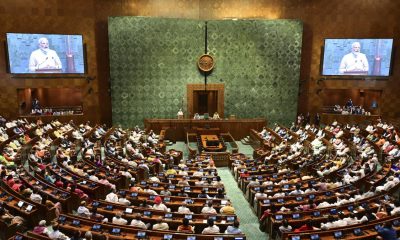Analysis
What will happen to Uganda if we start to grow GM crops?
One of the reasons why the U.S. and China are on top of the world is because they boldly venture into new areas as we stagnate with sometimes unnecessary fears.

National Crops Resources Research Institute (NaCRRI) Director Dr. Godfrey Asea shows the difference in pest resistance between GM and non-GM maize. The greener maize is GM.
At the national agricultural research facility in Namulonge, about 30km north east of Kampala, maize grows in a cage. With official clearance, a guard will ask you to enter your identity details in his long book before you can get in, as if to help him trace you in case you walked out with anything, if not to announce your status in case something bad happened to you.
Such is the deterrent and suspicious atmosphere that is associated with genetically modified (GM) crops in Uganda 26 years after the world’s first commercialised GM plant, tobacco, was introduced by China, and 22 years since the US commercialised GM maize.
If you were visiting this cage for the first time you would be forgiven to think there was some sort of witchcraft. Rows of healthy maize plants with big cobs thrive just next to rows of worm-infested and tattered ones. The healthy maize is GM, the worm-infested type is conventional -what we currently grow in our fields including hybrids.
Soon the GM maize will be harvested but no one will be allowed to eat it. It will be destroyed under the watchful eye of the Uganda National Bureau of Standards (UNBS). Why? Because it is GM maize – just that! Not because UNBS knows of any problem with it.
Talk to any scientist working here and you will feel a sense of pity – like their maize, they have been caged by anti-GM politics, and the delay to deliver this promising maize to millions of Ugandan farmers and to the national cereal granary continues despite scientific consensus that GM food is safe.
On my recent visit to Namulonge along with some journalists, I sat next to Isaac Ongu, a colleague with whom I had drawn the list for this trip, in the white van which picked me from Gayaza, 10km to the institute.
One of the reasons for our visit was to see maize that had succeeded in resisting devastating pests – the stem borer and the fall armyworm – and this was the GM maize. Those of you who have grown maize before understand how destructive those pests can be. Stem borers can destroy your crop by up to 80 percent while the fall armyworm can wipe out the entire field.
As we drove along the clean bitumen, lined either side by trees and scattered human settlements, we picked up a conversation on the importance of maize in Uganda’s trade. We discussed how, with increased productivity of this crop, Uganda had the potential to instantly propel standards of living and economic growth.
Maize is Uganda’s most important cereal crop with a commanding share of 75 percent – some annual average of close to three million metric tons. Maize provides 40% of calories consumed in Uganda. And in terms of export, maize is also the most dominant grain, with exports worth USD 78.6 million in 2015.
In the East African Community, Uganda and Tanzania are considered “surplus” maize producers, helping feed Kenya, Rwanda, Burundi and South Sudan whose production levels are lower. But that status may not make much sense if we considered the cost of livestock and poultry feeds in these countries, and its implication on the end prices of meat or chicken for example.
Maize is a key input in Uganda’s livestock and poultry – contributing over 50 percent by weight in most feeds. Every year poultry farmers, especially small scale farmers, are driven out of business due to high feed costs.
Low productivity, high regional demand and to some extent inadequate storage facilities often force the local price of maize in Uganda to more than double. In early 2017 the maize prices rose to UGX1,600 from UGX 600, that is a whole 167 percent increase.
Because of the high cost of feed, livestock and poultry products are expensive for the majority of Ugandans and thus less accessible. If Uganda produced more maize, it would produce more cattle, more milk, more chicken, more eggs, more pigs, more fish, the list is endless. There would be so much for the internal market and a lot for export. The Maize Value Chain is a huge industry Uganda is failing to exploit; we concluded our conversation as thus.
At the end of 2017 Parliament passed the Biotechnology and Biosafety Bill but President Museveni demanded some changes before he could assent to it. These have since been made and were recently tabled in Parliament by the responsible committee for science and technology. But the tone of the document is negative, including threats such as imprisoning farmers in case their GM crops cross-pollinated with non-GM crops.
It is now 15 years since President Museveni launched a modern biotechnology research laboratory in Kawanda and research in several crops including cassava, bananas, maize, potatoes and others has been on in several research stations across the country.
Success of GM crops in Uganda, in the research stations, is well documented but ignorance about the technology among policy makers continues to frustrate farmers’ access to the potentially-life changing crops. We stay conservative, locking our perception in imaginary threats other than visible opportunities.
Twenty six countries were commercially growing GM crops by 2016 with USA, Brazil, Argentina, Canada, India, Paraguay , Pakistan and China leading in that order. South Africa, not surprisingly, leads on the African continent. Nearly 20 million farmers were by 2016 growing GM, according to the International Service for the Acquisition of Agricultural Applications (ISAAA).
Here in Uganda we are still debating whether GM crops are safe or not. Our policy makers, over 90 percent of whom never attended a science class beyond O’ level, are the ones interpreting the science of genetic engineering for us. They are not even willing to listen to the professional advice of people who studied and know these things. Funny!
Societies have advanced primarily because of science and technology. We need to take up the GM crop now to boost our agricultural productivity and production. If we find it not working, or if we find it unsafe, we can abandon it and move on.
What makes us think that the world will end with the application of genetic engineering in our agriculture? China, US, and most especially South Africa must be wondering why we don’t see things the way they see them!
The Writer is the President & CEO of the Uganda Science Journalists Association (USJA)
Comments



























